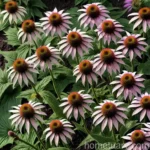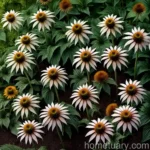Plant Profile: Purple Coneflower (Echinacea purpurea ‘Razzmatazz’)
In the exciting world of horticulture, one would be hard-pressed to find a more captivating and dynamic plant than the Purple Coneflower, scientifically known as Echinacea purpurea ‘Razzmatazz’. This stunning perennial plant not only adds a burst of vibrant color to gardens, but also boasts a myriad of benefits, from its medicinal properties to its role in wildlife gardening. In this comprehensive guide, we will explore the fascinating characteristics, cultivation practices, uses, and much more about the Purple Coneflower.

Image source: Wikimedia Commons
What is a Purple Coneflower (Echinacea purpurea ‘Razzmatazz’)?
The Purple Coneflower, Echinacea purpurea ‘Razzmatazz’, is a stunning and robust perennial plant that belongs to the Asteraceae family. This unique cultivar is an improved version of the traditional Purple Coneflower, featuring vibrant and exotic-looking flowers with rich hues of raspberry, purple, and magenta. With its striking appearance and impressive attributes, the ‘Razzmatazz’ variety has garnered considerable attention and popularity among gardening enthusiasts and professional landscapers.
Key Takeaways – Purple Coneflower (Echinacea purpurea ‘Razzmatazz’)
Before delving into the intricacies of cultivating and caring for the Purple Coneflower, it is essential to grasp some key takeaways about this captivating plant:
- Echinacea purpurea ‘Razzmatazz’ is a visually captivating perennial plant that features stunning shades of raspberry, magenta, and purple in its flowers.
- This plant is known for its drought tolerance and ability to attract pollinators, making it an excellent addition to both formal gardens and naturalistic landscapes.
- In addition to its ornamental value, Echinacea purpurea ‘Razzmatazz’ has significant medicinal properties and is traditionally used for its immune-boosting and wellness-enhancing effects.
- Proper care and cultivation practices, including suitable soil, sunlight, and watering, are essential for the optimal growth and health of Purple Coneflower plants.
With these key takeaways in mind, let’s embark on a comprehensive journey into the world of Echinacea purpurea ‘Razzmatazz’, exploring its cultural significance, uses, and cultivation best practices.
1. Culture
Uses
The Purple Coneflower (Echinacea purpurea ‘Razzmatazz’) is a versatile plant with a wide range of uses, making it a valuable addition to various garden settings and landscaping schemes. Some of its primary uses include:
- Ornamental Value: With its bold and distinctive flowers, ‘Razzmatazz’ adds visual interest and a burst of color to gardens, borders, and mixed perennial beds.
- Medicinal Properties: Echinacea purpurea is renowned for its medicinal benefits, attributed to its immune-boosting and wellness-enhancing properties. It is used in herbal remedies and wellness preparations.
- Wildlife Gardening: The nectar-rich flowers of the Purple Coneflower attract beneficial pollinators such as bees and butterflies, contributing to the overall biodiversity and ecological balance in gardens.
2. Water
Proper watering is crucial for the overall health and vitality of Purple Coneflower plants. While these plants exhibit a degree of drought tolerance once established, they benefit from regular watering, especially during dry periods. The following guidelines can help ensure adequate water management for Echinacea purpurea ‘Razzmatazz’:
- Establishment Phase: Newly planted Purple Coneflowers should be watered consistently to promote root establishment and initial growth. Water deeply and thoroughly, allowing the soil to remain moist but not waterlogged.
- Established Plants: Once established, Echinacea purpurea ‘Razzmatazz’ can thrive in drier conditions. However, during prolonged periods of drought or heat, it is advisable to provide supplemental irrigation to maintain the plant’s vigor and flowering performance.
- Watering Tips: When watering, it is best to apply water at the base of the plant, near the root zone, to ensure efficient moisture uptake. Additionally, using mulch around the base of the plant can help conserve soil moisture and reduce the frequency of watering.
3. Sunlight
Purple Coneflower (Echinacea purpurea ‘Razzmatazz’) thrives in sunny locations and displays its best growth and flowering performance when provided with ample sunlight. Here are some essential considerations regarding sunlight requirements for this vibrant perennial:
- Full Sun Exposure: Echinacea purpurea ‘Razzmatazz’ prefers full sun, which typically denotes at least six to eight hours of direct sunlight daily. When planted in a sunny location, the plant is more likely to produce an abundance of colorful blooms and exhibit sturdy, compact growth.
- Partial Shade: While Echinacea purpurea can tolerate partial shade, it is best to prioritize sunny sites for optimal performance. In regions with intense summer heat, providing some afternoon shade can be beneficial, especially to mitigate excessive stress on the plant during the hottest parts of the day.
4. Fertilizer
Appropriate fertilization can play a pivotal role in supporting the growth, vigor, and flowering capacity of Purple Coneflower plants. When considering fertilization for Echinacea purpurea ‘Razzmatazz’, the following recommendations are essential:
- Soil Assessment: Before applying fertilizers, it is advisable to conduct a soil test to determine the existing nutrient levels and any deficiencies that may need to be addressed. This enables targeted and precise fertilization practices.
- Balanced Fertilizer: Select a balanced, slow-release fertilizer with a nutrient ratio suited for flowering perennials, such as a 10-10-10 formulation. Apply the fertilizer in spring as new growth emerges, following the manufacturer’s instructions for application rates.
- Organic Amendments: Incorporating organic matter, such as well-rotted compost or aged manure, into the soil around Purple Coneflower plants can provide a supplementary source of nutrients and contribute to soil fertility over time.
5. Soil
The soil composition and quality are pivotal factors influencing the growth, health, and flowering performance of Purple Coneflower (Echinacea purpurea ‘Razzmatazz’) plants. When selecting and preparing the soil for these vibrant perennials, consider the following aspects for optimal results:
- Well-Draining Soil: Echinacea purpurea ‘Razzmatazz’ flourishes in well-drained soils that allow excess moisture to escape readily. To enhance soil drainage, consider amending heavy or compacted soils with organic matter, such as compost or peat moss, to improve structure and porosity.
- Soil pH: Echinacea purpurea prefers slightly acidic to neutral soil pH in the range of 6.0 to 7.0. Conduct a soil pH test to ascertain the existing pH level and, if necessary, adjust it by incorporating suitable amendments to achieve the desired range.
- Soil Texture: The ideal soil texture for Purple Coneflower plants is loamy and friable, promoting ease of root penetration and moisture retention while preventing waterlogging or excessive compaction.
6. Pruning
Proper and timely pruning is essential for maintaining the vigor, form, and flowering prowess of Echinacea purpurea ‘Razzmatazz’. By implementing appropriate pruning practices, gardeners can enhance the plant’s health and aesthetic appeal while managing its growth effectively. Here are some indispensable insights into pruning Purple Coneflower plants:
- Deadheading: Regular deadheading of spent flowers promotes prolonged blooming and prevents the formation of seeds, thereby encouraging the plant to invest its energy in producing additional blooms.
- Stem Pruning: Pruning back the stems of Purple Coneflower plants after the initial flowering period can stimulate new growth and encourage a second wave of blooms, extending the floral display into late summer or early fall.
7. Propagation
Multiplying and propagating Purple Coneflower (Echinacea purpurea ‘Razzmatazz’) enables gardeners to expand their plantings and introduce new specimens into various garden settings. Several effective propagation methods can be employed to propagate Echinacea purpurea ‘Razzmatazz’, including:
- Division: Dividing established clumps of Purple Coneflower is a reliable and straightforward method of propagation. When plants are dormant or just beginning to emerge in early spring, carefully lift and divide the clumps, ensuring that each division possesses sufficient roots and growing points.
- Seed Sowing: Growing Echinacea purpurea ‘Razzmatazz’ from seeds offers an opportunity to propagate numerous plants and showcase the diverse floral variations inherent in this cultivar. Sow the seeds in well-draining, fertile soil in spring or fall, and provide consistent moisture and warmth for successful germination and establishment.
8. Container Popularity
The allure of Purple Coneflower (Echinacea purpurea ‘Razzmatazz’) extends beyond traditional garden settings, as it is increasingly favored for container gardening due to its compact growth habit and captivating floral display. By cultivating Echinacea purpurea ‘Razzmatazz’ in containers, gardening enthusiasts can enjoy its beauty and benefits on patios, balconies, and small urban spaces.
- Container Selection: Choose spacious containers with adequate drainage holes to accommodate the root system of the Echinacea purpurea ‘Razzmatazz’ plant and facilitate proper moisture management.
- Potting Mix: Utilize a well-draining potting mix formulated for perennial plants, ensuring that the container medium offers sufficient aeration and water retention without becoming waterlogged.
9. Common Diseases
While Purple Coneflower (Echinacea purpurea ‘Razzmatazz’) is resilient and robust, it can be susceptible to certain diseases and ailments, particularly when subjected to unfavorable growing conditions or environmental stressors. Understanding these common diseases and implementing preventive measures is crucial for safeguarding the health and vigor of Purple Coneflower plants.
Disease Diagnosis
- Powdery Mildew: A prevalent fungal disease, powdery mildew can affect the foliage of Purple Coneflower, manifesting as a powdery white coating on the leaves. Provide proper air circulation, avoid overhead watering, and employ fungicidal treatments if necessary to manage and prevent powdery mildew.
10. Common Pests
The resilience of Purple Coneflower against pest infestations is generally high, but certain pests may pose occasional challenges to the plant’s health. By recognizing these common pests and implementing effective pest control strategies, gardeners can mitigate potential damages to Echinacea purpurea ‘Razzmatazz’.
Botanist’s Tips
Our botanist’s tips offer valuable insights and recommendations for cultivating and caring for Purple Coneflower (Echinacea purpurea ‘Razzmatazz’) to promote its optimal growth and maximize its ornamental and ecological benefits.
Botanist’s Tip #1: When selecting a planting location for Echinacea purpurea ‘Razzmatazz’, prioritize well-drained soils and sunny sites to ensure the plant’s vigor and robust flowering performance.
Botanist’s Tip #2: Incorporate Purple Coneflower plants into wildlife-friendly garden designs to attract pollinators, enhance biodiversity, and contribute to sustainable and ecologically conscious landscaping practices.
Botanist’s Tip #3: To encourage prolonged blooming and prevent self-seeding, deadhead spent flowers regularly and consider implementing stem pruning after the initial flowering period to stimulate a second wave of blooms.
Fun Facts
In addition to its captivating appearance and practical uses, the Purple Coneflower (Echinacea purpurea ‘Razzmatazz’) harbors several fascinating and remarkable qualities. Discover some intriguing fun facts about this vibrant perennial plant:
- The vibrant and captivating flowers of Echinacea purpurea ‘Razzmatazz’ are beloved by pollinators such as butterflies and bees, contributing to the overall ecological balance and biodiversity in gardens.
- Echinacea purpurea has a rich and storied history in traditional herbal medicine, esteemed for its immune-boosting and wellness-enhancing properties for generations.
- The ‘Razzmatazz’ cultivar offers an exotic and alluring twist on the traditional Purple Coneflower, with its dazzling hues of raspberry, purple, and magenta captivating the admiration of gardening enthusiasts worldwide.
Links to External Resources
For further exploration and in-depth information about Purple Coneflower (Echinacea purpurea ‘Razzmatazz’) and related topics, the following external resources are invaluable sources of knowledge and insights:
- Missouri Botanical Garden: Echinacea purpurea ‘Razzmatazz’
- University of Vermont Extension – Echinacea purpurea: Purple Coneflower
- Royal Horticultural Society: Growing Coneflowers
Conclusion
In the realm of ornamental and functional plants, Echinacea purpurea ‘Razzmatazz’ stands out as a beacon of beauty, resilience, and ecological significance. From its striking floral spectacle to its valuable medicinal properties and its role in promoting biodiversity, the Purple Coneflower embodies a harmonious blend of ornamental and ecological benefits.
By embracing the insights and guidelines presented in this comprehensive guide, gardeners and plant enthusiasts can embark on a meaningful and rewarding journey of cultivating, caring for, and celebrating the enchanting allure and practical virtues of Purple Coneflower (Echinacea purpurea ‘Razzmatazz’). With its radiant and captivating presence, this remarkable perennial plant enriches landscapes, nourishes wildlife, and captivates the hearts of all who behold its resplendent beauty.
In a world where beauty, functionality, and ecological responsibility converge, Echinacea purpurea ‘Razzmatazz’ emerges as an exemplary ambassador of horticultural splendor and ecological harmony, inviting us all to partake in its exceptional magnificence and profound significance.
Research:
1. RHS: Echinacea purpurea
2. Plant Finder: Razzmatazz Coneflower















